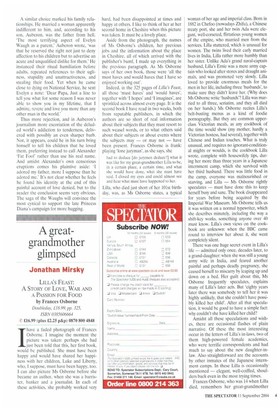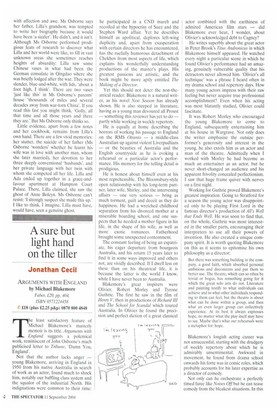A great grandmother glimpsed
Jonathan Mirsky
LILLA'S FEAST: A STORY OF LOVE, WAR AND
A PASSION FOR FOOD
by Frances Osborne
Doubleday, £18.99, pp. 325, ISBN 0385606664 £16.99 (plus £2.25 p&p) 0870 800 4848 Ihave a faded photograph of Frances Osborne. I imagine the moment the picture was taken: perhaps she had just been told that this, her first book, would be published. She must have been happy and would have shared her happiness with her children, Luke and Liberty, who, I suppose, must have been happy, too. I can also picture Ms Osborne before she became an author, when she was a barrister, banker and a journalist. In each of these activities, she probably worked very
hard, had been disappointed at times and happy at others. I like to think of her at her second home in Cheshire when this picture was taken. It must be a lovely place.
Aside from the photograph, the names of Ms Osborne's children, her previous jobs and the information about the place in Cheshire. all of which arrived with the publisher's bumf, I made up everything in the previous paragraph. As Ms Osborne says of her own book, those were 'all the must haves and would haves that I have so enjoyed working out'. Indeed, in the 325 pages of LiHa's Feast, all those 'must haves' and 'would haves', together with 'I hopes' and 'I imagines', are sprinkled across almost every page. It is the second book I have read in two weeks, both from reputable publishers, in which the authors are so short of real information about their subjects that they must resort to such weasel words, or to what others said about their subjects or about events where the subjects may — or may not — have been present. Frances Osborne is frank: playing 'lone juryman', as she says, she
had to deduce [do jurymen deduce] what it was like for my great-grandmother Lilla to he, in a certain place, a certain time, and what she would have done, what she must have said. I closed my eyes and could almost see and hear what must have happened to her.
Lilla, who died just short of her 101st birthday, was. as Ms Osborne states, a typical woman of her age and imperial class. Born in 1882 in Chefoo (nowadays Zhifu), a Chinese treaty port, she and her twin Ada were elegant, well-corseted, flirtatious young women of the empire, who married men from the services. Lilla stuttered, which is unusual for women. The twins lived their early married lives in India, Lilla rather more humbly than her sister. Unlike Ada's grand naval-captain husband, Lilla's Ernie was a mere army captain who looked after stores and draught animals, and was promoted very slowly. Lilla loved to provide enormous meals for the men in her life, including three 'husbands', to make sure they didn't leave her. (Why does Ms Osborne write `husbands'? Lila was married to all three, seriatim, and they all died on her hands.) Ms Osborne recites Lilla's belt-busting menus as a kind of foodie pornography. But they are common upperclass Victorian meals, as any cookbook of the time would show (my mother, hardly a Victorian hostess, had several), together with Chinese and Indian touches. What is truly unusual, and requires no ignorant-conditional mights or woulds, is the cookbook Lilla wrote, complete with housewifely tips, during her more than three years in a Japanese internment camp, which she survived with her third husband. There was little food in the camp, everyone was malnourished or starving, and Lilla — Ms Osborne rightly speculates — must have done this to keep herself busy and sane. The book disappeared for years before being acquired by the Imperial War Museum. Ms Osborne tells us it was written on a normal typewriter, which she describes minutely, including the way a shift-key works, something anyone over 40 must know. Lilla's own views on the cookbook are unknown; when the BBC came round to interview her about it, she went completely silent. There was one huge secret event in Lilla's life — admitted only once, decades later, to a grand-daughter: when she was still a young army wife in India, and feared another painful and perhaps deadly pregnancy, she caused herself to miscarry by leaping up and down on a bed. Her guilt about this, Ms Osborne frequently speculates, explains many of Lilla's later acts. But 'eighty years later there was somebody to tell her it was highly unlikely, that she couldn't have possibly killed her child'. After all that speculation, it would be good to have a simple fact: why couldn't she have killed her child? Amidst all these speculations and wishes, there are occasional flashes of plain narrative. Of these the most interesting occur in the letters of Lilla's in-laws, two of them high-powered female academics, who were terrific correspondents and had much to say about the new daughter-inlaw. Also straightforward are the accounts by other inmates of the Japanese internment camps. In these Lilla is occasionally mentioned — elegant, well-coiffed, shoulders back even in the most trying times.
Frances Osborne, who was 14 when Lilla died, remembers her great-grandmother
with affection and awe. Ms Osborne says her father, Lilla's grandson, was tempted to write her biography because it would have been 'a sizzler'. He didn't, and it isn't. Although Ms Osborne performed prodigious feats of research to discover what Lilla and her world were like, to fill in vast unknown areas she sometimes reaches heights of absurdity: Lilla saw some Chinese vases in what had been the German consulate in Qingdao where she was briefly lodged after the war. They were slender, blue-and-white, with lids, 'about a foot high, I think'. There are two vases 'just like this' in Ms Osborne's parents' house 'thousands of miles and several decades away from war-torn China'. If you read this fast you might think, 'Golly, all that time and all those years and there they are.' But Ms Osborne only thinks so.
Little evidence, apart from a few notes and her cookbook, remains from Lilla's own hand. There are a few vivid memories: her stutter, the suicide of her father (Ms Osborne 'wonders' whether he learnt his wife was in love with another man, whom she later married), her devotion to her three deeply conventional 'husbands', and her private language with her twin with whom she competed all her life. Lilla and Ada ended up together in a grace-andfavour apartment at Hampton Court Palace. There, Lilla claimed, she saw the ghost of Anne Boleyn. Ms Osborne can't resist: 'I strongly suspect she made this up.' I like to think, I imagine, Lilla must have, would have, seen a genuine ghost.











































































 Previous page
Previous page